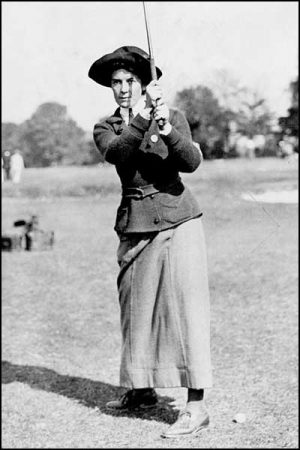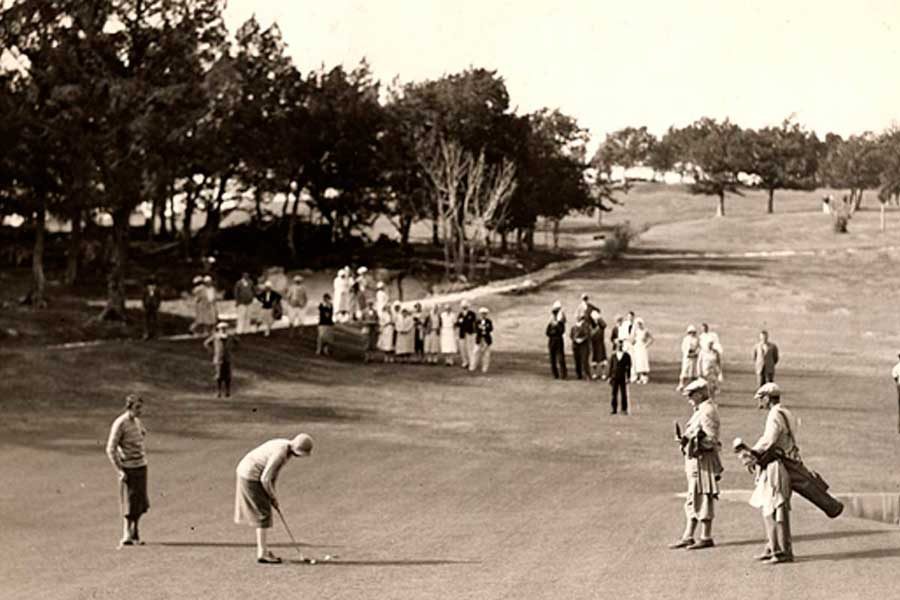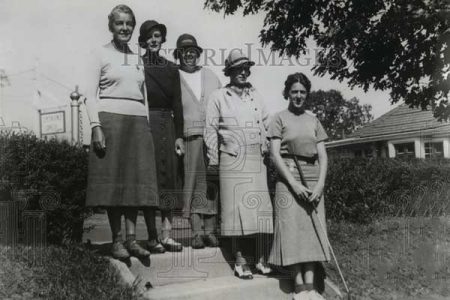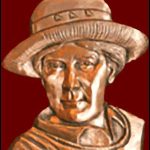Dorothy Campbell Hurd Howe
Dorothy Campbell Hurd Howe World Golf Hall of Fame: Year Inducted: 1978
The early years of woman’s golf that paved the way for female golfers including Bardwell Valley Golf Club here in Australia.
Dorothy Campbell Hurd Howe was the first golfer to win both the U.S. Women’s Amateur and the Women’s British Amateur in the same year (1909). Dorothy Campbell Hurd was the first woman to dominate international golf. Between 1905 and 1912, she won 10 national championships in America, England, Scotland and Canada. Then, 12 years later, she won the American title once more.
As Dorothy Campbell, and later as Mrs. J.V. Hurd, her count of national amateurs was three U.S., two British, three Scottish and three Canadian. In 1909, she became the first woman to win the U.S. and British Amateurs in the same year.
Dorothy Campbell was born in 1883 in North Berwick, Scotland. The town’s famous links, where her paternal grandfather and eight uncles all played, proved her playground. She took her first swing when she was 18 months, and by age five, was playing matches against her older sisters.
Dorothy Campbell was born in 1883 in North Berwick, Scotland. The town’s famous links, where her paternal grandfather and eight uncles all played, proved her playground. She took her first swing when she was 18 months, and by age five, was playing matches against her older sisters.
Campbell did not evolve into a top player until her later teens, when she changed what had been a half swing into a full one. In 1905, Campbell won her first Scottish Ladies title. Played at the North Berwick links, more than 4,000 people watched her win the final on the 19th hole.
She repeated in 1906 and 1908. The next year she entered the U.S. Women’s Amateur for the first time and won at the Merion Cricket Club. When she returned to achieve her first victory in the British Women’s Amateur Championship at Royal Birkdale, it was an unprecedented double.
In 1910, Campbell moved to Canada and won the country’s championship three consecutive years before moving to the United States permanently in 1913. When she won the American title again in 1924, she was 41 years old. She remains the championship’s oldest winner, and her 15-year span between victories is also the longest in the event’s history.
Hurd advanced women’s golf in America by being the first to aim directly at the pin on her approaches instead of just the general vicinity of the green. She had a tremendous short game, which she once said, “is almost second nature to me.” A deadly putter, she was even better from just off the green.
Dorothy Lee Campbell was a Scottish female amateur golfer, and first woman to win the American, British and Canadian Women's Amateurs.
Her favorite club was a goose-necked mashie she called “Thomas.” It was “Thomas” that she gave credit to for her American-British double for in the semifinal at Birkdale she used the club to hole out from a dead stymie at a crucial point in the match. In the final of the 1921 North and South championship at Pinehurst, “Thomas” holed two shots.
After her flurry of national titles, Campbell married and her golf career hit a fallow period. When she lost the final of the 1920 U.S. Amateur to Alexa Stirling, it appeared to be her last hurrah. But in 1923, seeing that many women were out-driving her by using a more modern technique, she concluded that her game needed updating.
She changed her swing from a stiff-wristed, sweeping-type motion that produced a straight but short left-to-right shot to a more athletic action in which hand action played an important part. Working with George Sayers, the pro at Merion who was also from North Berwick, she forced herself to switch from the baseball to the Vardon grip. After 10 months of work, Hurd was literally a new player.
At the 1924 U.S. Amateur at Rhode Island C.C., she rolled through the field, ultimately defeating Mary K. Browne, the national lawn tennis champion of 1912 and 1913, 7 and 6, in the final.
Although it was Hurd’s last championship, she was far from finished as a golfer. In 1926, she set out to surpass the record for fewest putts in 18 holes, 21, which had been set by Walter J. Travis. At the Augusta C.C., Hurd came to the 18th hole with 19 putts, when she holed out from off the green using “Thomas,” her famous mashie.
Other Significant Victories:
1905: Scottish Ladies Championship
1906: Scottish Ladies Championship
1908: Scottish Ladies Championship
1909: U.S. Women’s Amateur, British Women’s Amateur
1910: U.S. Women’s Amateur, Canadian Ladies Open
1911: British Women’s Amateur, Canadian Ladies Open
1912: Canadian Ladies Open
1924: U.S. Women’s Amateur
1938: U.S. Women’s Senior Championship
Jack V. Hurd (m. 1913–1923; divorced)
Edward Howe (m. 1937–1943; divorced)
Son: Sigourney V. Hurd (1913–1986)
Marriages and children
She married Jack V. Hurd in Wentworth, Ontario, Canada on February 11, 1913. Jack V. Hurd was a steel magnate living in Pittsburgh, Pennsylvania, and a member of Oakmont Country Club. She won many of her titles as Mrs. J. V. Hurd, but she and Hurd were divorced in 1923.
She had a son, Sigourney V. Hurd (1913–1986), with Jack Hurd.
She married Edward Howe in 1937 and divorced again in 1943.
In her career she was also known in her lifetime as Dorothy Hurd, Mrs. J. V. Hurd and as Dorothy Howe. She has also been referred to by the portmanteau as Dorothy Campbell Hurd Howe.
Legacy
She was inducted to the Canadian Golf Hall of Fame and the World Golf Hall of Fame in 1978.
Death
She died in a railway accident on March 20, 1945, falling off a platform and into the path of an oncoming train. Her death certificate shows her full name to be Dorothy Lee Howe. The principal causes of death were a skull fracture and avulsion of her right arm.










